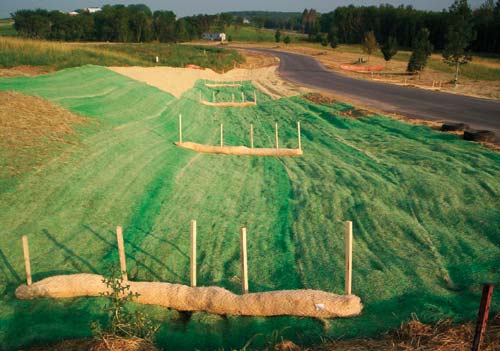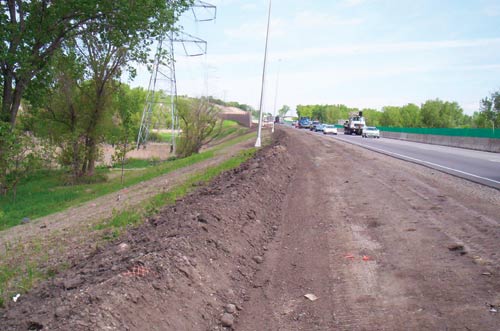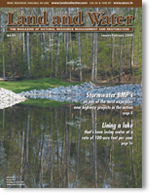
It takes more work and more materials to keep projects in compliance. The SWPPP and the budget must include the appropriate BMP’sand the extra work required. Photo credits: Storm Water Compliance Team Bonestroo Rosene Anderlik.
As soon as I start talking about implementing the storm water pollution prevention plan on projects then agency personnel, compliance inspectors, watershed staff, and State and municipal inspectors stop in their tracks and try to listen in. It’s as if I were an investment advisor from Smith Barney sitting at the next table in a restaurant. When I ask the construction team including project managers, about implementing the SWPPP I normally get two types of responses. Either they bite their lip in silence or they wait for me to answer my own question. When I ask contractors, they are concerned about whether the provisions have been shown and are included in the Plan. When I ask owners the same SWPPP question, they seem to be concerned about how this will affect their project in regard to completion date and cost.
The bottom line is that there are many different responses about the apparent difficulties of implementing the SWPPP. During my travels and while attending various meetings and conferences there is an overriding concern in this industry of getting provisions for erosion control and storm water management carried out in a timely manner during construction. I have heard the concern time and time again.
In my previous article (November/December 2006, Land and Water) I mentioned that the goal is implementing the BMP’s and the requirements of the SWPPP during construction as a routine method of doing construction. What does it take? Are there gaps? Is there a silver bullet? How do we start? What has been tried?
As I also mentioned in my previous article, I recommend that the SWPPP is designed by the design professionals and included in the contract plans, specifications, the project proposal and the project budget. So I believe that is the starting point. But lining up at the starting gate is just the beginning of the race. Is there enough in reserve and an adequate plan to finish the race?
| I have seen Engineers preparing new specifications by taking previous specifications and tweaking the specs just enough to fit their project. Standard drawings and details are in the same format that they have been in for forty years. |
Breaking the Old Habit
One of the issues that I see is that we are creatures of habit. Designers have a tendency to take previous plans off the shelf and make the new plan similar to the previous plan. I have seen Engineers preparing new specifications by taking previous specifications and tweaking the specs just enough to fit their project. Standard drawings and details are in the same format that they have been in for forty years. I have seen construction project managers gloss over the new specifications on their construction project and abide by previous specifications and previous methods. I have seen seed mixtures referenced on projects that have not been specified for over 20 years. Another of my observations is that prime contractors have a tendency to hire the same subcontractors and obtain materials from the same suppliers. But, don’t misinterpret me. Hiring the same subcontractors may not be bad. The overriding problem that I see is using the same construction methods, the same BMPs , the old construction scheduling, the old “one thing at a time” approach, not changing our Design or Plan provisions and the inability to adapt to new requirements time after time. Does the old statement “If it ain’t broke don’t fix it” seem to apply?
I once asked an adult education specialist, who had a master’s degree in education and more than 20 years of experience in adult training, what it took in terms of education to change peoples habits. His reply was that it took repeating the message over and over again and also reinforcement. I asked how many times does the message have to be repeated? He said that it varied, that the average was twenty times and that after 400 times it was basically a lost cause. Being an Engineer I love numbers and target values. I concluded that we have to repeat the message a minimum of twenty times to those involved at each stage of designing and implementing the SWPPP.
But my adult training specialist also mentioned reinforcement. This reminds me of a time a couple years ago that I was frustrated about the lack of seeding and mulching on a project. Disturbed slopes just sat open week after week with no cover and they were next to a couple of wetlands and a river. I had talked to the construction people several times and also to the contractor. What was really bothersome was that they had all been to training that we had provided and they had done very well in the training. In frustration I called another contractor and asked him what does it take? I will always remember his reply … you need to bug us. Don’t give up. Keep bugging us. We need you to keep coming out on the projects and talking to us. I reached another conclusion… reinforcement was definitely necessary.

We need to ensure that we are training all those involved with designing and implementing the SWPPP provisions on projects.
If At First You Don’t Succeed
To obtain implementation I think that it is human nature to “racket up” with each sequential specification that is prepared. For example, if we didn’t get the implementation of erosion control practices we were looking for on a particular project, we would make the provisions on the next project much more “complete” and difficult. Then we would follow all these new specifications and requirements with training. Does this sound familiar? Yup, that’s what I did. I would create more specs and more training and follow that by more specs and more training. During a flurry of specs and training, several of my staff complained that they were “ trained out”. I would then call my colleages in other states and ask “what are you training about this year?”. Their immediate response was “The new specs we put together.” I reached another conclusion: creating new specifications and following up with training is a standard practice used to obtain implementation of the SWPPP requirements. But, are we providing training to all the people involved or the right people? Do all these new specs do the job?
| And, if we have only provided training for the construction inspector, it’s like playing a new game during construction with only one person that knows the new rules. In addition, the person that is trained has very little, if any, authority over the budget, project scheduling or the actual operations. |
What Have We Tried?
The process I have observed is that we start with a review of the permit language and one or two people’s interpretation of the requirements. Then detailed drawings of BMP’s are prepared, approved products lists are expanded, and narrative verbiage regarding permit requirements are included in the specifications. Typically the narrative verbiage attempts to make the contractor responsible. We follow these activities by training at least one construction inspector per project. At this stage of the game, we seem to forget what should be included in the project budget for the new requirements. And, if we have only provided training for the construction inspector, it’s like playing a new game during construction with only one person that knows the new rules. In addition, the person that is trained has very little, if any, authority over the budget, project scheduling or the actual operations.
The next stage that I see are expanded detail drawings, an advanced listing of approved products, more creative specifications, new handbooks, and some pay items for temporary sediment capture in the Plans. At this point I have not observed much in the SWPPP for provisions or payment for temporary erosion control measures. The budget seems to be expanded slightly to cover one installation of temporary sediment capture devices. Also it is at this time that I frequently hear conversation about possible certification training programs.
As an Engineer I am reminded that no dynamic process is 100 percent efficient. Even if the process approached 100 percent efficiency it means that we have to put in at least as much or more than we can expect out of the system. In other words, how can we expect more out of our process for implementing erosion and sediment control best management practices on projects than we are willing to budget for and include in the project Plans?
Something Else Is Missing
I see big gaps in the process that we have typically been using. Some of the gaps such as lack of budgeting for the additional new requirements, not including provisions in the Plans and training only the project inspector have already been mentioned. We also need shared responsibility, feedback from construction personnel and contractors, a training program that includes all the participants, targeted design provisions, and a rational method to determine what the budget should be for keeping projects in compliance. It takes more work and more materials and a better Plan to keep the projects in compliance. In my previous article, I mentioned that a rough estimate of the cost is approaching six to seven percent of the project cost. Of course this rough estimate varies considerably dependent on the project work, location and nearby water resources.

The goal is to implement erosion and sediment control BMP’s and the provisions of the SWPPP as a routine method of doing construction.
Summary
We need a SWPPP designed by design professionals showing the latest requirements. The SWPPP must contain current specifications, up-to-date BMPS, estimated quantities of the BMP’s, pay items for the BMP’s and related work and an actual budget estimate of the work and materials required. We need to update our materials, our scheduling of the work on the project and our construction methods. We need to repeat the message and we need to do positive reinforcement. I also mentioned education. Education is not the end. It is the beginning.
| Compliance with the intent of the storm water regulations is a step-bystep process.. The series of articles which I am submitting are intended to identify areas where we as professionals can make some positive improvements. |
Recommendations
First, I would recommend that the contractor obtain the permit and sign the permit application as a copermitee. Secondly, I would require the prime contractor to have an erosion control supervisor designated from their upper level supervisory staff available on the project. The erosion control supervisor is the go-to person on the project for all matters dealing with the contractors erosion/sediment control work and scheduling. I would require mandatory training for all foremen and superintendents involved with grading, culvert placement, bridge construction, utility work, and any other work which could impact water resources. Passing an exam at the completion of the training would be required. I would also recommend the project Engineers and project inspectors be required to attend the same training and pass the exam. There should also be separate targeted training for designers on how to prepare a SWPPP, how to estimate quantities and what to include in the project plans. Another of the essential steps is having contractors and construction personnel attend some short facilitated meetings at the end of the construction season to get their feedback on improvements and needed changes. Then we need to implement these suggested changes in the project plans on future projects.
Compliance with the intent of the storm water regulations is a step-by-step process. There are many people involved and many people to inform. The series of articles which I am submitting are intended to identify areas where we as professionals can make some positive improvements. In conclusion, I took to heart the statement by the contractor “You need to bug us”. In my next article I will expand further on provisions that have been included in projects for implementing the SWPPP during construction. 
|




